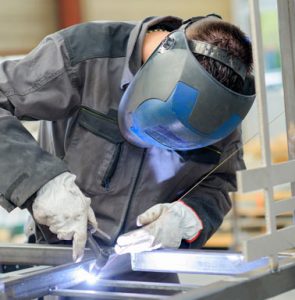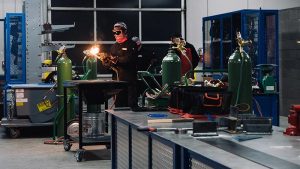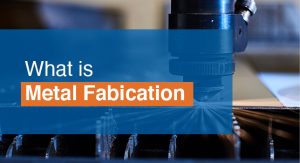What is Metal Fabrication
Metal fabrication is the process of shaping and fabricating metal through a variety of processes, consisting of cutting, rolling, bending, and welding. It is a process that can be used to create a variety of different objects, from small components to large structural pieces.
Metal fabrication starts with an idea, typically born out of necessity, that involves a piece of metal suited for some particular task. Metal fabrication is important in many industries, from automotive to construction. It allows for the creation of strong and durable products that can be used in a variety of applications. There are many different types of metals that can be fabricated, each with its own unique properties and advantages.
What is the custom metal fabrication process and what are its uses
 Metal fabrication is a process that can be used to create a variety of different objects, from small components to large structural pieces. It is an important process in many industries, from automotive to construction.
Metal fabrication is a process that can be used to create a variety of different objects, from small components to large structural pieces. It is an important process in many industries, from automotive to construction.
One of the main uses for metal fabrication processes is in manufacturing. Metal fabrication can be used to create everything from small parts and components to entire structural pieces for buildings. It is also commonly used in the automotive industry, where it is used to create parts and components for cars and trucks.
Another common use for the metal fabrication process is in the construction industry. Metal fabrication can be used to create a variety of different products, from beams and columns to trusses and framing. It is also commonly used to create stairs, railings, and other architectural elements.
Metal fabrication is a versatile process that can be used to create a wide range of products. It is an important part of many industries and can be used to create everything from small parts to large structural pieces.
How are custom metal fabrication processes performed?
The types of metal fabrication can vary depending on the type of metal being used and the object being created. However, there are a few basic steps that are common to most metal fabrication processes.
The first step is to cut the metal into the desired shape. This can be done with a variety of different tools, lasers, plasma torches, and water jets.
Next, the metal is then rolled into the desired shape. This can be done with a rolling machine using the correct machinery or by hand.
After that, the metal is bent into the desired shape. This can be done with a variety of different tools, bending brakes, press brakes, and hammers.
Lastly, the metal is welded together to create the final product. This can be done with a variety of different welding processes, arc welding, gas welding, and oxy-fuel welding to name a few.
How the process works
Metal fabrication begins with the cutting and bending of the metal into the desired shape. This can be done with a variety of different tools, lasers, plasma torches, and water jets. Next, the metal is then rolled into the desired shape. This can be done with a rolling machine or by hand. After that, the metal is bent into the desired shape. This can be done with a variety of different tools, which include bending brakes, press brakes, and hammers.
Once the metal has been cut and bent into the desired shape, it is then welded together to create the final product. This can be done with a variety of different welding processes, including arc welding, gas welding, and oxy-fuel welding.
The different types of metals that can be fabricated
 There are a wide variety of different metals that can be fabricated, each with its own unique properties and advantages. Some of the most common types of metals that can be fabricated include:
There are a wide variety of different metals that can be fabricated, each with its own unique properties and advantages. Some of the most common types of metals that can be fabricated include:
Steel: Steel is a common type of metal that is strong and durable. It is often used in construction and manufacturing applications.
Aluminum: Aluminum is a lightweight metal that is often used in automotive and aerospace applications.
Copper: Copper is a soft metal that is often used in electrical applications.
Brass: Brass is a strong metal that is resistant to corrosion. It is often used in plumbing and musical instrument applications.
The process of metal fabrication – 3 main techniques…
The process of metal fabrication can be divided into four main steps: cutting, rolling, bending, and welding.
In the cutting step, the metal is cut to the desired shape using a variety of different tools, lasers, torches, and saws.
In the rolling step, the metal is passed through a series of rollers to achieve the desired thickness.
In the bending step, the metal is bent into the desired shape using a variety of different tools, presses and brake dies.
In the welding step, the metal is joined together using a variety of different welding processes, forging, metal stamping, arc welding, gas welding, and resistance welding.
How to choose the right metal fabrication company
When choosing a metal fabrication company, it is important to consider a variety of different factors. Some of the most important factors to consider include:
- The experience and expertise of the company
- Range of services offered by the company
- Quality of the products produced by the company
- The pricing of the products and services
- Commercial, Industrial, or residential only
The benefits of metal fabrication
There are a number of benefits to using metal fabrication. Some of the most notable benefits include:
Strength and durability:
Metal fabrication typically produces products that are strong and durable. They can withstand a lot of wear and tear and are resistant to corrosion.
Versatility:
Metal fabrication is a versatile process that can be used to create a wide range of products.
Cost-effective:
Metal fabrication is a cost-effective way to create metal products. It is often less expensive than other methods, such as casting or machining.
Quick and easy:
Sheet Metal fabrication is a quick and easy process that can be completed in a relatively short amount of time.
Since each project is different a metal fabricator may be required to use laser cutting, press brake, or roll forming equipment.
What is a metal fabricator?
 A metal fabricator is a professional who specializes in the fabrication of metal products. They use a variety of different processes, including cutting, rolling, bending, and welding, to create a wide range of products, from small parts to large structural pieces. Metal fabricators are an important part of many industries and can be used to create everything from cars to aircraft.
A metal fabricator is a professional who specializes in the fabrication of metal products. They use a variety of different processes, including cutting, rolling, bending, and welding, to create a wide range of products, from small parts to large structural pieces. Metal fabricators are an important part of many industries and can be used to create everything from cars to aircraft.
Metal fabricators use computer-aided design programs (CAD) or computer-aided manufacturing (CAM) during the manufacturing process. This allows them to create products that meet the specific requirements of their clients. There are many different kind of metal parts, plate metal, and materials that may be required for select projects. Some can be sourced from local machine shops.
The most admired skill of a quality metal fabricator is the ability to convert raw metal materials into polished final products. They are also able to follow specific blueprints or instructions to create products that meet the specific requirements of their clients.
Some of the most popular services that metal fabricators offer include laser cutting, press brake forming, and shearing. These services allow them to create a wide variety of products, from small parts to large structural pieces.
How to fabricate sheet metal
Sheet metal can be fabricated through a variety of different processes, including cutting, rolling, bending, punching and welding. In the cutting step, the metal is cut to the desired shape using a variety of different tools, including lasers, torches, and saws. In the rolling step, the metal is passed through a series of rollers to achieve the desired thickness. In the bending step, the metal is bent into the desired shape using a variety of different tools, including presses and brake dies. In the welding step, the metal is joined together using a variety of different welding processes, including arc welding, gas welding, and resistance welding.
What is the difference between welding and metal fabrication?
Welding is a process that can be used to join metal together. There are a variety of different welding processes, including arc welding, gas welding, and resistance welding. Metal fabrication is the process of shaping and fabricating metal through a variety of processes, including cutting, rolling, bending, and welding. It is a process that can be used to create a variety of different objects, from small components to large structural pieces.
Commercial Manufacturing Equipment in Sheet Metal Fabrication
Commercial Manufacturing Equipment is a broad term that can encompass a variety of different machines. In metal fabrication, it typically refers to machines that are used to create large-scale metal products. Some of the most common types of commercial manufacturing equipment include laser cutters, press brakes, and roll forming machines.
Laser cutters are used to cut metal into the desired shape using a high-powered laser. Press brakes are used to bend metal into the desired shape using a series of press dies. Roll forming machines are used to roll metal into the desired thickness and shape.
Each type of machine has its own advantages and disadvantages. Laser cutters are very precise and can cut complex shapes, but they are also very expensive. Press brakes are less expensive than laser cutters, but they can only bend metal into simple shapes. Roll forming machines are less expensive than press brakes, but they can only roll metal into simple shapes.
When choosing commercial manufacturing equipment, it is important to consider the specific needs of your project. If you need to cut complex shapes, you will need a laser cutter. If you need to bend metal into complex shapes, you will need a press brake. If you need to roll metal into complex shapes, you will need a roll-forming machine.
What are the Benefits of Sheet Metal Fabrication Shops?
There are a variety of benefits that a metal fabrication shop can offer. They can provide a wide range of services and material, from laser cutting to press brake forming. They can also create a variety of different products, from small parts to large structural pieces. Metal fabrication shops can also offer a variety of different pieces of metal and finishing options, including powder coating and plating.
FAQ
What is metal fabrication?
Metal fabrication is the process of shaping and fabricating different types of metal through a variety of processes, including cutting, rolling, bending, and welding. It is a process that can be used to create a variety of different objects, from small components to large structural pieces.
What are the benefits of metal fabrication?
There are a number of benefits to using metal fabrication. Some of the most notable benefits include: strength and durability, versatility, cost-effectiveness, and quick and easy production.
What is a metal fabricator?
A metal fabricator is a professional who specializes in the fabrication of metal products. They use a variety of different processes, including cutting, rolling, bending, and welding, to create a wide range of products, from small parts to large structural pieces. Typically, a fabrication shop bids on a job, usually based on engineering drawings, and if awarded the contract, builds the product.
Conclusion:
Metal fabrication is a process that can be used to create a variety of different objects, from small components to large structural pieces. It is a quick and easy process that can be completed in a relatively short amount of time. In addition to its versatility, metal fabrication offers a number of benefits, including strength and durability, cost-effectiveness, and ease of production.

